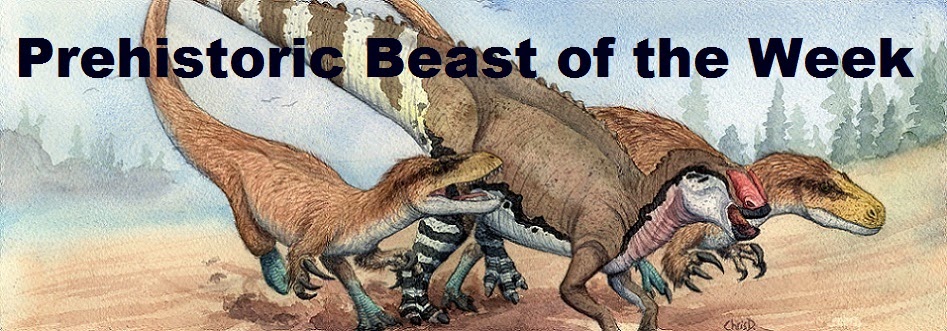.jpg) |
| Watercolor life reconstruction of Ceratosaurus nascornis eating the ancient lungfish, Ceratodus robustus by Christopher DiPiazza. |
 |
| Bronze cast of a Ceratosaurus skull on display at the Mesalands Dinosaur Museum in Tucumcari new Mexico. |
The most notable feature about Ceratosaurus is the presence of its "horns". These bony structures aren't really horns as much as they are crests, however, since they were extremely thin and delicate. Whereas the horns of certain other dinosaurs, like Carnotaurus, were robust enough to have been effective weapons in life, the "horns" of Ceratosaurus would have easily broken if they were used in any sort of violent activity. They were most likely used for display rather than for physical fighting. Keep in mind that these crests would have had a layer of keratin growing over them, so they might have appeared even longer and possibly even a slightly different shape in life. A juvenile Ceratosaurus skeleton that was discovered showcases proportionally smaller crests on its skull, supporting the idea that they were for display, possibly helping individuals within the species to identify others as sexually mature or not. They may have also been for display against other species, making Ceratosaurus' head look bigger and therefore more intimidating to rival meat-eaters, like Allosaurus.
 |
| Juvenile Ceratosaurus skull on display at the North American Museum of Ancient Life. Note the smaller crests on the nose and above the eyes. (Photo credit: Jens Lallensack) |
The crests weren't Ceratosaurus' only unique feature. This dinosaur also had a row of small bony plates, called osteoderms, running down the center of its back. This is a feature common in certain groups of dinosaurs, like the thyreophorans, like Stegosaurus, but is extremely rare in theropods. The exact purpose is a mystery, but we can make some educated guesses. As with the head crests, these bony structures may have aided in display to other dinosaurs. Perhaps males had longer plates than females? Perhaps they were absent in juveniles? Maybe they helped camouflage Ceratosaurus slightly by breaking up its basic body shape? We may never know for sure.
 |
| Neck of the Ceratosaurus skeleton on display at the Smithsonian National Museum of Natural History in Washington D.C. I circled a group of the osteoderms in yellow. |
Ceratosaurus' tail was particularly deep and flattened laterally. This lead some to hypothesize that Ceratosaurus may have been a decent swimmer and specialized in hunting aquatic prey. (although there is little other evidence that suggests this) Ceratosaurus also had short, but fully functional arms each tipped with four fingers and three claws.
Lastly, Ceratosaurus had the longest teeth proportional to its body of any known dinosaur. The teeth were curved and serrated, like steak knives. They look to be ideal for slashing chunks of flesh from bone, rather than crushing through armor and bone. This is further supported by the fact that Ceratosaurus' lower jaw was rather thin, and therefore wouldn't have been capable of applying too much force or withstanding too much pressure before being injured.
 |
| Almost-complete(no arms!) Ceratosaurus skeletal mount on display at the National Museum in Washington D.C. |
Ceratosaurus bones have been found in the same formations as other, larger Jurassic meat eaters, like Allosaurus and Torvosaurus. Most scientists agree that Ceratosaurus may have specialized in hunting a different kind of prey than its larger contemporaries, perhaps going after smaller animals, rather than giant sauropods and heavily-armed stegosaurs. This is further supported by the fact that Ceratosaurus bones are particularly less common than most of the other dinosaurs known from the Late Jurassic of North America. This could mean that Ceratosaurus typically dwelled in habitats slightly different from the rest of those dinosaurs where fossilization didn't take place as easily.
Sometimes I wonder what exactly prevented Ceratosaurus from existing close to the other megapredators of it's time...
 |
| They said it couldn't be done but I managed to make a cartoon merging Late Jurassic predators with Mean Girls. It wasn't even that hard. |
That's all for this week! As always feel free to comment below! Want to see a particular prehistoric beastie reviewed? Let me know and I'll make it happen!
Works Cited
Carrano, M.T.; Sampson, S.D. (2008). "The Phylogeny of Ceratosauria (Dinosauria: Theropoda)". Journal of Systematic Palaeontology. 6 (2): 183–236.
Foster, John (2007). "Gargantuan to Minuscule: The Morrison Menagerie, Part II". Jurassic West: The Dinosaurs of the Morrison Formation and Their World. Indiana University Press. pp. 162–242.
Gilmore, C.W. (1920). "Osteology of the carnivorous Dinosauria in the United States National Museum, with special reference to the genera Antrodemus (Allosaurus) and Ceratosaurus". Bulletin of the United States National Museum 110: 1–154.
Marsh, O.C. (1884). "Principal characters of American Jurassic dinosaurs, part VIII: The order Theropoda". American Journal of Science 27 (160): 329–340.
Rowe, T.; Gauthier, J. (1990). "Ceratosauria". In Weishampel, D.B.; Dodson, P.; Osmólska, H. The Dinosauria. University of California Press. pp. 151–168.





.jpg)


.jpg)


.jpg)



.jpg)

